

Oldest Modern Human Bones Ever Found In Asia Help Settle Debate Over Human Migration. By: Charles Choi, LiveScience Contributor Published: 08/20/2012 03:14 PM EDT on LiveScience.
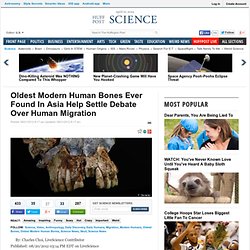
Sunday Morning Bobblehead Thread. Embarrassed By Your Olympic Javelin: Did Cavemen Do It Better? : Krulwich Wonders... Stronger, faster, fiercer, finer.

That's what the Olympics promise us — higher performance, new world records. But not if you throw things. The javelin throw has been an Olympic event since 1908. Since then, great athletes, mostly Swedes, Norwegians and Germans, kept throwing spears farther and farther until the extraordinary moment in 1984 — not at the Olympics, it was at a track and field meet in Berlin — when German Uwe Hohn threw so high, so far, he not only broke the previous world record, he scared the bejeezus out of the security people. You've got to see this. Track and field 1984 Javelin World Record - Uwe Hohn DDR. 104.80 Meters Uwe's throw broke the 100-meter barrier.
500 Million-Year-Old 'Mistake' Led to Humans. - A genetic process that went wrong 500 million years ago led to the evolution of humans and other vertebrates. - The event, which resulted in doublings of genes, also led to proteins responsible for many of today's diseases. - Studying these proteins could help researchers learn more about human evolution and the inner workings of diseases.
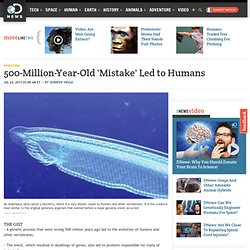
Over 500 million years ago a spineless creature on the ocean floor experienced two successive doublings in the amount of its DNA, a "mistake" that eventually triggered the evolution of humans and many other animals, says a new study. The good news is that these ancient DNA doublings boosted cellular communication systems, so that our body cells are now better at integrating information than even the smartest smartphones. What Vikings really looked like. The fine decoration of the Oseberg ship in Norway, which was buried in the year 834, provides clues to what Vikings looked like.
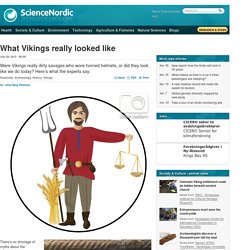
Inside the ship were two women and the archaeologists believe the ship has served as a sarcophagus. (Photo: Annie Dalbéra) Support from the relationship of genetic and geographic distance in human populations for a serial founder effect originating in Africa. Proceedings of the National Academy of Sciences of the United States of Americawww.pnas.org Author Affiliations Contributed by L.

Luca Cavalli-Sforza, September 2, 2005 Abstract. Founder effect. Simple illustration of founder effect.

The original population is on the left with three possible founder populations on the right. In population genetics, the founder effect is the loss of genetic variation that occurs when a new population is established by a very small number of individuals from a larger population. It was first fully outlined by Ernst Mayr in 1942,[1] using existing theoretical work by those such as Sewall Wright.[2] As a result of the loss of genetic variation, the new population may be distinctively different, both genotypically and phenotypically, from the parent population from which it is derived.
Does the African genome hold the secrets of a previously unknown species of hominid? Human Ancestors Were Nearly All Vegetarians. Blogging the Human Genome: Why do we have two fewer chromosomes than our closest primate relatives? Illustration by Andrew Morgan Humans have 46 chromosomes. Our closest primate relatives have 48. So where did those extra two disappear to? Chris Stringer on the Origins and Rise of Modern Humans. In Ancient Ore. Dump, Clues To The First Americans? Hide captionDisplayed in the hand of University of Oregon archaeologist Dennis Jenkins are three bases for western stemmed projectiles from the Paisley Caves in Oregon.
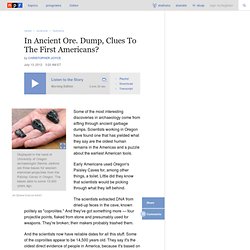
The bases date to some 13,000 years ago. Jim Barlow/Science/AAAS Displayed in the hand of University of Oregon archaeologist Dennis Jenkins are three bases for western stemmed projectiles from the Paisley Caves in Oregon. The bases date to some 13,000 years ago. Some of the most interesting discoveries in archaeology come from sifting through ancient garbage dumps. Early Americans used Oregon's Paisley Caves for, among other things, a toilet. Early Americans Took Two Tool Tracks. Domestication of Felines" In sharp contrast to dogs, cats did not evolve to look or act very different from their wild ancestors.

This fact has made it difficult for scientists to determine when exactly cats domesticated. Although evidence shows that cats probably did not evolve from modern large cats, such as lions and tigers, Archaeologists cannot use the shapes of old bones and scientists cannot investigate DNA to distinguish between ancient small wild cats and modern domesticated cats. Preface: Theory of Evolution. Theories of Evolution The idea of evolution is of great antiquity.
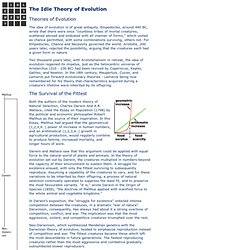
Empedocles, around 440 BC, wrote that there were once "countless tribes of mortal creatures, scattered abroad and endowed with all manner of forms," which united as chance permitted, with some combinations surviving, others not. For Empedocles, Chance and Necessity governed the world. Aristotle, 200 years later, rejected the possibility, arguing that the creatures each had a given form or nature. Two thousand years later, with Aristotelianism in retreat, the idea of evolution regained its impetus, just as the heliocentric universe of Aristarchus (310 - 230 BC) had been revived by Copernicus, Kepler, Galileo, and Newton. 'Britain's Atlantis' found at bottom of North sea - a huge undersea kingdom swamped by a tsunami 5,500 years ago. Divers have found traces of ancient land swallowed by waves 8500 years agoDoggerland once stretched from Scotland to DenmarkRivers seen underwater by seismic scansBritain was not an island - and area under North Sea was roamed by mammoths and other giant animalsDescribed as the 'real heartland' of EuropeHad population of tens of thousands - but devastated by sea level rises By Rob Waugh Published: 23:32 GMT, 2 July 2012 | Updated: 10:49 GMT, 3 July 2012.

Meteorite Crater In Greenland Called World's Oldest, Biggest. Legendary Viking town unearthed. The excavation work is mainly carried out by young archaeologists. (Photo: University of Aarhus) Danish archaeologists believe they have found the remains of the fabled Viking town Silasthorp by the Schlei bay in northern Germany, near the Danish border. According to texts from the 8th century, the town served as the centre of power for the first Scandinavian kings. But historians have doubted whether Sliasthorp even existed. This doubt is now starting to falter, as archaeologists from Aarhus University are making one amazing discovery after the other in the German soil. "This is huge. Maya archaeologists unearth new 2012 monument. (Phys.org) -- Archaeologists working at the site of La Corona in Guatemala have discovered a 1,300 year-old year-old Maya text that provides only the second known reference to the so-called “end date” for the Maya calendar on December 21, 2012.
The discovery, one of the most significant hieroglyphic find in decades, was announced today at the National Palace in Guatemala. “This text talks about ancient political history rather than prophecy,” says Marcello A. Canuto, Director of Tulane’s Middle American Research Institute and co-director of the excavations at the Maya ruins of La Corona. “This new evidence suggests that the 13 Bak’tun date was an important calendrical event that would have been celebrated by the ancient Maya; however, they make no apocalyptic prophecies whatsoever regarding the date," says Canuto. In 2012, Canuto and Barrientos decided to excavate in front of a building that had been heavily damaged nearly 40 years ago by looters looking for carved stones and tombs. An Interview With Freeman Dyson on the Origins of Life on Earth. Mystical marks in virgin forest explained.
Patches of bark have been removed from older pines in the Øvre Dividalen National Park, but not in ways that would prevent the trees from continuing to grow. (Photo: UiT) During a recent mapping of the rare virgin forest in and around the Øvre Dividalen National Park in Troms, Norway, scientists noticed some scars reappearing on the trees. Many trees had some of their bark cut away on one side, leaving marks that were hard to explain. Ancient North Africans Got Milk. Unearthing the cause of mass extinction. The structures look like big volcanoes. Calcium Offers Clues In Mass Extinction. With Science, New Portrait of the Cave Artist. A more likely situation, the researchers said, is that the art — 50 samples from 11 caves in northwestern Spain — was created by anatomically modern humans fairly soon after their arrival in Europe.
The findings seem to put an exclamation point to a run of recent discoveries: direct evidence from fossils that Homo sapiens populations were living in England 41,500 to 44,200 years ago and in Italy 43,000 to 45,000 years ago, and that they were making flutes in German caves about 42,000 years ago. Then there is the new genetic evidence of modern human-Neanderthal interbreeding, suggesting a closer relationship than had been generally thought.
The successful application of a newly refined uranium-thorium dating technique is also expected to send other scientists to other caves to see if they can reclaim prehistoric bragging rights. Bronze Age people with a mine of their own. Earliest Known Human Relatives Came from Asia. - A new fossil primate, Afrasia, is related to, but more primitive than, an early African primate from Libya. Americans' Heads Getting Bigger In Size, Changing Shape, Anthropologists Say. Did the 20th century make us big-headed? Mankind's remotest relative is the protozoan. The woman from Huldremose. Natmus.dk: RSS feeds Udskriv siden Read this. Dyed clothes came into fashion in early Iron Age. Immigration in the Stone Age.
A longhouse from a reconstructed Iron Age farm at Ullandhaug in Stavanger. (Photo: Gunleiv Hadland/Wikimedia Commons) Colour secrets revealed in fossilised fish-eye. Springfield Coal Fossil Forest Is Largest Ever Discovered (PHOTOS) Saturday Art: Mayan Art And Their Remarkably Accurate Calendar. Maya Artwork Uncovered In A Guatemalan Forest. Did All Dinosaurs Have Feathers? New Studies of Permian Extinction Shed Light on the ‘Great Dying’ How agriculture came to Scandinavia. Mapping China's Ancient Name Game. Where's the Beef? Early Humans Took It. Ancient Walking Gets Weirder. Leaving tracks − with words. Www.pnas.org/content/suppl/2012/03/28/1117620109.DCSupplemental/pnas.201117620SI.pdf. Inuit drum history longer than realised. New Ancestor Grasped At Walking. Slacker Rat, Worker Rat. African Fossil Foot Indicates Another Hominin Species Lived With Lucy. The mysterious stone Madonna of the North.
What Hides Head Statue On Easter Island (4 pics) Decode Stela 3. Was human evolution caused by climate change? Research-based cookbook for cavemen and Vikings. Stone Age cartoons. 512 - A Hand Map of 'Swantacruz' and Environs. Streck:WassermanIraq73(2011),117–125.pdf. An Evolution Animation Unlike Any You’ve Seen Before… Chimp 'Police' Keep Peace Among Apes, Primate Researchers Say.
Ancient seagrass: 'Oldest living thing on earth' discovered in Mediterranean Sea. On deep history and the brain. Raising the Dead: New Species of Life Resurrected from Ancient Andean Tomb. Shelters Date To Stone Age. The real caveman diet: What did people eat in prehistoric times? New Life, From an Arctic Flower That Died 32,000 Years Ago. Oceans Set Stage For Human Evolution. Archaeoacoustics: Tantalizing, But Fantastical.